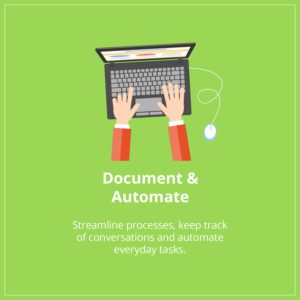 As Founder of Squirrel Business Solutions, I advise SMEs on cloud-based business systems. Over the past six years, I’ve been privileged to work with hundreds of companies, which has given me a useful insight into business practices. Time and again, I’ve witnessed people entering the same data into their database or CRM, then again into their accounting package, and sometimes even for a third time into their calendar or marketing software.
As Founder of Squirrel Business Solutions, I advise SMEs on cloud-based business systems. Over the past six years, I’ve been privileged to work with hundreds of companies, which has given me a useful insight into business practices. Time and again, I’ve witnessed people entering the same data into their database or CRM, then again into their accounting package, and sometimes even for a third time into their calendar or marketing software.
I’ve also seen how many hours can go into copying and pasting the same content to create proposals for different clients, sending them as email attachments and coordinating comments and signatures. It’s painful to see how many errors can creep in along the way, particularly as a result of manual entry and poor version control – and astonishing how much valuable, potentially billable, time is wasted.
Turning goals into action
It’s never been easier to improve business efficiency, but it can be hard to translate such a broad goal into action. One way to tackle it is to think of it as a three-phase process: Implement, Integrate, Automate.
The first phase is finding and implementing the right system. A CRM (customer relationship management) system is often at the core of the solution because it provides a central database for all information relating to a customer and forms a useful hub to which other systems can be connected.
Which brings us to the second step: integration. Many systems are designed to work together, and getting them to talk to each other – or integrating them – can open up sophisticated functionality that would not otherwise be available. For example, integration makes it possible to change a customer’s contact details in your CRM and have them automatically updated in your accounting package, email marketing account or document-management system. There’s no need for double or triple data entry, less room for error and one central source of truth.
The beauty of automation
Having the right systems in place and integrated paves the way for automation. Using data as a trigger, systems can be set up to carry out any number of processes automatically. For example, if a CRM like Zoho is integrated with an email marketing service such as MailChimp, the receipt of a web enquiry can automatically trigger the sending of welcome and lead-nurture emails.
In another example, a Zoho CRM–PandaDoc integration helped one of our clients speed up their sales cycle by a massive 30%. They were copying and pasting using Word to create sales documents, which they then emailed to their clients to print out, sign, scan and return. This process was so repetitive, inconsistent, prone to error and time-consuming that it was delaying project sign-off. But after integrating their Zoho CRM with the PandaDoc document-management system, our clients could build proposals pre-populated with data already in the CRM using a series of tick boxes and templates, and have the completed and signed documents automatically saved as PDFs and stored in the CRM.
Although modern technology makes it easy to achieve efficiency, people feel daunted by the many options out there and the prospect of having to invest time in learning the software. But taking the time to map out your workflow before making the switch will bring clarity about your requirements and ultimately save time. Getting advice on what’s possible with the systems you have, or plan to implement, and choosing an internal champion to work with a knowledgeable implementation partner will also smooth the transition to greater efficiency. You won’t look back!
Ask Squirrel
Squirrel Business Solutions specialises in finding the right system for a business, and then getting it set up, trained and up and running as quickly and as seamlessly as possible. Contact us to find out how we could help you make your business more efficient.

